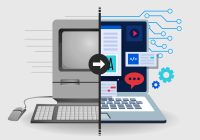Welcome to the fascinating world of AI-generated artworks! In this article, we’ll take you on a journey through the convergence of art and technology, where sophisticated artificial intelligence has unlocked unparalleled levels of creativity, blurring the lines between human and machine.
Introduction: Artistic Prowess Powered by AI
In today’s age, computers have evolved beyond mundane tasks and are now making their mark in the realm of art. Imagine a machine that can compose music, write poetry, and even direct animated shorts! The technological prowess of AI has enabled computers to exhibit artistic capabilities that were once deemed exclusive to human creators. Although some critics argue that AI can’t compete with human-made art due to the absence of human qualities like intuition and emotion, recent advancements have shown us a different perspective.
AI is no longer confined to data processing; it has ventured into the world of creativity, producing astonishing results. Major media outlets like the Associated Press and The Washington Post have harnessed AI’s power to churn out articles on various topics, proving its potential as a content creator. Sony, among other corporations, has released music tracks entirely composed by AI, pushing the boundaries of what we thought was possible.
The Rise of Creative Machines
The emergence of AI-generated artworks is a testament to the evolution of artificial intelligence. Early attempts at AI focused on rule-based approaches and exhaustive datasets, but the real game-changer came with “deep learning.” Using artificial neural networks, computers can now learn from examples and refine their abilities, just like humans. This breakthrough paved the way for machines to “think” critically and demonstrate creativity, opening doors to endless possibilities in the realm of art.
The Intricacies of AI-Generated Art
One of the fascinating aspects of AI-generated art is the use of Generative Adversarial Networks (GANs). These linked networks work together, with one generating original information and the other verifying its authenticity. The iterative process between the two systems leads to the creation of increasingly realistic output, showcasing AI’s ability to imitate real characteristics and produce mesmerizing artworks.
Copyright Conundrum: Addressing Ownership of AI-Generated Creations
With AI gaining creative abilities, the realm of copyright law faces new challenges. The primary goal of copyright legislation is to incentivize and reward creators for their original works. However, the introduction of AI complicates matters when it comes to authorship and ownership. Who truly owns the rights to AI-generated creations?
Unlike traditional art, AI-generated art poses unique questions about attribution. The traditional notion of the “human creator” is no longer applicable, leading to debates about whether AI can be granted copyright protection or if it should be in the public domain. The legal framework must evolve to accommodate the complexities of AI-generated art and strike a balance between protecting creators and fostering innovation.
The Data Revolution: AI’s Creative Fuel
One of the critical elements fueling AI’s creative endeavors is data. Unlike traditional programming, where every step is predetermined, AI relies on massive quantities of data to “learn” and develop artistic capabilities. The data inputs, provided by end-users or corporations like the Associated Press, contribute significantly to the evolution of AI algorithms, enriching their creative potential.
Determining copyright ownership in AI-generated art becomes intricate when the algorithms undergo modifications that were not explicitly guided by their original programmers. As AI systems evolve, the value of these modifications becomes undeniable, raising questions about the ownership of evolving code.
Embracing Change: The Future of AI and Copyright Law
As AI continues its rapid advancement, the future of copyright law lies in embracing change. We must adapt to the increasing influence of AI in creative expression and develop legal provisions that address the challenges while promoting innovation.
Ensuring the protection of creators, incentivizing AI programmers, and safeguarding the public’s interests are all crucial aspects of this evolving landscape. By striking a balance between ownership and accessibility, we can cultivate a thriving environment where AI and human creativity coexist harmoniously.
In conclusion, AI-generated art represents an exciting chapter in the history of creativity. As technology advances, we must stay vigilant in shaping copyright law to cater to the changing landscape and embrace AI’s potential as a powerful ally in the world of art and beyond.
Here are some frequently asked questions (FAQ)
What is AI-generated art, and how does it work?
- AI-generated art refers to artworks created by computers using sophisticated artificial intelligence algorithms. These algorithms employ deep learning and neural networks to analyze vast amounts of data, learn from examples, and generate original pieces of art.
Can AI-produced art match the creativity of human-made art?
While AI-generated art has made remarkable strides, it still lacks human qualities like intuition and emotion. Critics argue that AI cannot compete with the depth of human creativity, but recent advancements have shown AI’s ability to mimic real characteristics and produce inventive works.
How is AI impacting the creative landscape?
- AI is revolutionizing the creative landscape by providing new tools and capabilities for artists, writers, and musicians. It enables them to explore unique avenues of expression and enhances their creative process by generating ideas, assisting with content creation, and inspiring original works.
What are Generative Adversarial Networks (GANs) in AI art?
- GANs are linked networks used in deep learning to generate more realistic-looking outputs. One system creates original information, while the other evaluates its authenticity. This iterative process improves the AI’s ability to imitate real characteristics, contributing to the creation of impressive artworks.
Who owns the copyright to AI-generated art?
- The question of ownership in AI-generated art is complex. Traditionally, copyright protection is granted to human creators, but AI-generated art challenges this notion. Determining copyright ownership involves considering the contributions of programmers, AI algorithms, and data inputs.





